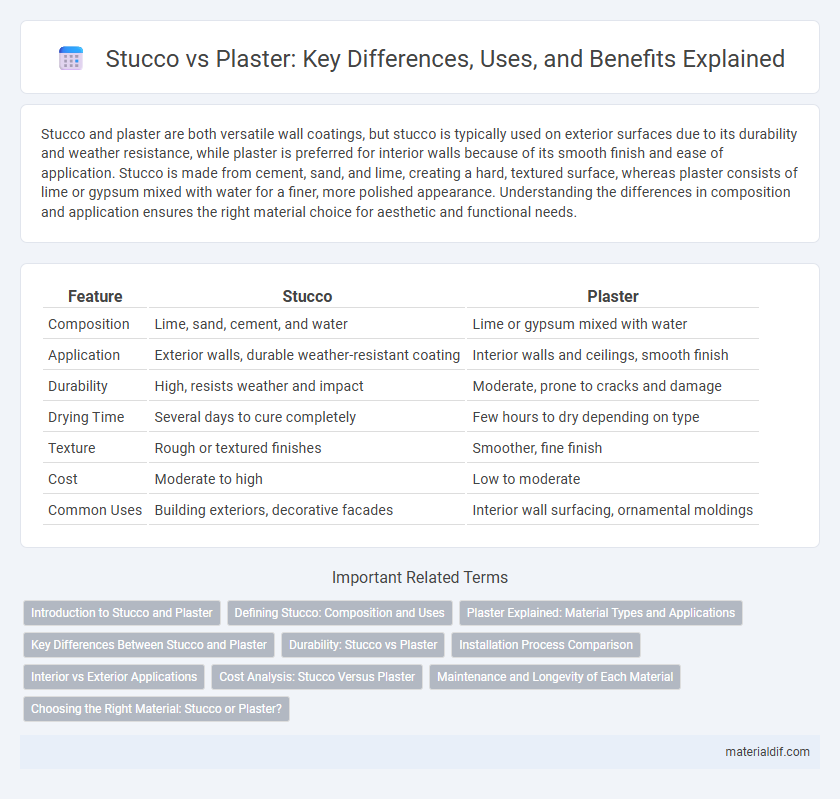Stucco and plaster are both versatile wall coatings, but stucco is typically used on exterior surfaces due to its durability and weather resistance, while plaster is preferred for interior walls because of its smooth finish and ease of application. Stucco is made from cement, sand, and lime, creating a hard, textured surface, whereas plaster consists of lime or gypsum mixed with water for a finer, more polished appearance. Understanding the differences in composition and application ensures the right material choice for aesthetic and functional needs.
Table of Comparison
| Feature | Stucco | Plaster |
|---|---|---|
| Composition | Lime, sand, cement, and water | Lime or gypsum mixed with water |
| Application | Exterior walls, durable weather-resistant coating | Interior walls and ceilings, smooth finish |
| Durability | High, resists weather and impact | Moderate, prone to cracks and damage |
| Drying Time | Several days to cure completely | Few hours to dry depending on type |
| Texture | Rough or textured finishes | Smoother, fine finish |
| Cost | Moderate to high | Low to moderate |
| Common Uses | Building exteriors, decorative facades | Interior wall surfacing, ornamental moldings |
Introduction to Stucco and Plaster
Stucco is a durable exterior finish made from cement, sand, and lime, commonly used to protect and decorate building facades. Plaster, composed primarily of gypsum, lime, or cement, serves as an interior wall and ceiling coating providing a smooth surface. Both materials differ in application and composition, with stucco offering weather resistance and plaster enhancing interior aesthetics.
Defining Stucco: Composition and Uses
Stucco is a cement-based plaster composed primarily of lime, sand, and Portland cement, designed for exterior wall finishes due to its durability and weather resistance. Its coarse texture allows for superior adherence and protects buildings from environmental elements while providing an aesthetically versatile surface. Commonly used in Mediterranean and southwestern architecture, stucco offers both structural reinforcement and decorative appeal for facades and outdoor walls.
Plaster Explained: Material Types and Applications
Plaster is a versatile building material primarily composed of gypsum, lime, or cement, each offering distinct properties suited for specific applications. Gypsum plaster provides a smooth, fire-resistant finish ideal for interior walls, while lime plaster offers breathability and flexibility, making it suitable for historic restorations. Cement plaster is highly durable and water-resistant, commonly used for exterior surfaces to protect against weather damage.
Key Differences Between Stucco and Plaster
Stucco is a durable exterior finish primarily composed of cement, sand, and lime, designed for weather resistance and structural protection, while plaster is a softer interior finish made from gypsum, lime, or cement that enhances wall smoothness and aesthetics. Stucco typically involves a layered application process creating a hard, textured surface suitable for outdoor use, contrasting with plaster's smooth, sculptable finish ideal for indoor surfaces. The differences in composition and application reflect their distinct functions: stucco offers durability for exterior walls, whereas plaster provides decorative versatility indoors.
Durability: Stucco vs Plaster
Stucco offers superior durability compared to traditional plaster, as it is designed to withstand harsh weather conditions and resist cracking over time. Stucco's composition typically includes cement, sand, and lime, which creates a tougher, more weather-resistant surface than the gypsum-based plaster. This makes stucco ideal for exterior applications, while plaster is generally preferred for interior walls due to its smoother finish but lower resistance to moisture and impact.
Installation Process Comparison
Stucco installation involves applying a durable cement-based mixture in multiple layers over wire mesh or lath, requiring curing time between coats to achieve a weather-resistant finish. Plaster is applied by hand in thinner layers directly onto interior walls or ceilings using a trowel, often requiring skilled craftsmanship for smooth, detailed surfaces. Stucco demands more robust preparation and ventilation during curing, whereas plaster focuses on fine surface finish and faster drying times indoors.
Interior vs Exterior Applications
Stucco is a durable exterior finish that provides weather resistance and is typically applied over masonry or wood surfaces, making it ideal for outdoor walls. Plaster, known for its smooth and fine texture, is primarily used for interior applications to create decorative ceilings and walls with high aesthetic appeal. While stucco withstands harsh environmental conditions, plaster excels in controlling indoor humidity and enables intricate detailing in interior spaces.
Cost Analysis: Stucco Versus Plaster
Stucco generally costs between $6 to $9 per square foot, making it more economical for exterior finishes compared to plaster, which ranges from $8 to $12 per square foot due to its labor-intensive application. The material composition of stucco, primarily cement, sand, and lime, allows for faster installation and lower labor costs, while plaster requires skilled craftsmanship using gypsum or lime-based mixtures. Homeowners aiming to balance durability and budget often find stucco offers a cost-effective solution for exterior walls, whereas plaster remains preferred for detailed interior work despite its higher price.
Maintenance and Longevity of Each Material
Stucco offers superior durability and requires minimal maintenance, with its weather-resistant properties allowing it to last up to 50 years or more when properly applied. Plaster, while providing a smooth and elegant finish indoors, is more prone to cracking and water damage, necessitating more frequent repairs and maintenance typically every 10 to 20 years. Investing in stucco ensures long-term resilience for exterior surfaces, whereas plaster is best suited for interior applications where moisture exposure is limited.
Choosing the Right Material: Stucco or Plaster?
Stucco, composed of cement, sand, and lime, is highly durable and ideal for exterior walls due to its resistance to weather and cracking. Plaster, made primarily from gypsum or lime, offers a smoother finish and is preferred for interior walls, providing excellent soundproofing and fire resistance. Selecting between stucco and plaster depends on the application area, environmental exposure, and desired texture or durability for a long-lasting finish.
Stucco vs Plaster Infographic

 materialdif.com
materialdif.com